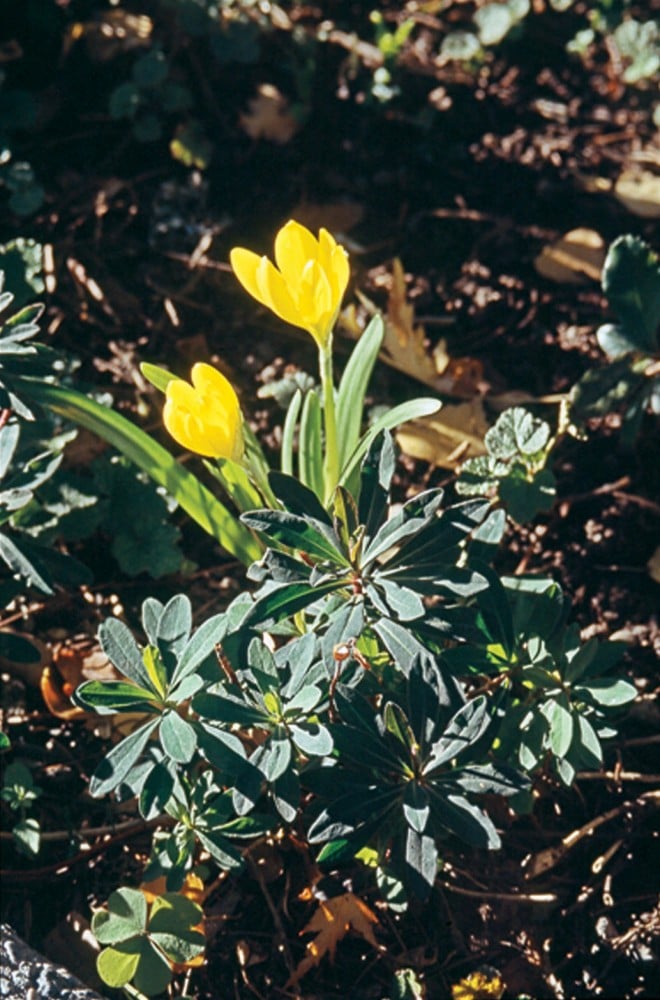

Contributor
- Topics: Archive

It is in the [mediterranean] autumn, after summer drought and dormancy, that the yearly life cycle of plants starts anew, like the awakening in spring that follows winter dormancy in the north.
Heidi Gildemeister, Gardening the Mediterranean Way
I used to think of plants that bloomed in fall as freaks of nature and confusers of seasons. Though Thoreau suggested that fragments of each season might be found in any other, my aesthetic image of autumn didn’t include the pastel lilac pink of autumn crocus. To me, they looked as out of place as tulips in July.

Then one October in Southern France, I found what these autumn-blooming flowers were about. All through one night, wind shook the shutters. Thunder cracked along the steep ridge above. Rain fell in torrents, spilling down the rocky slope and coursing through the village streets. The next morning, the storm gave way to mist that lifted as the sun warmed the damp earth. The landscape felt soft and spring-like. Bees buzzed through the shrubs; gnat-like insects hovered above the rain washed foliage, and birds twittered and fluttered in and out of shadows. The honeyed scent of alyssum drifted up from the doorstep garden and arbutus bloomed in the nearby maquis. While the foliage of the village’s plane trees and woodland chestnuts faded to yellows and tans, there came a counter vernal awakening, a soft autumn echo of the spring that follows winter.

In the northern Mediterranean Region, unlike California and the adjacent Pacific states, there is often an autumn peak in precipitation. This peak provides a spring-like window for plant growth and flowering. Soil moisture accumulates. Air temperatures, moderated by the Mediterranean Sea, remain relatively warm. The window for growth closes slowly as temperatures drop, but not before the landscape returns to green, and a generation of autumn blooming plants rendezvous with a generation of pollinators.
A number of fall-flowering species have close relatives that bloom in early spring. In the Mediterranean, this means that their flowers avoid the most desiccating season: summer. Familiar examples are the crocuses, which are among the earliest harbingers of spring, but which also have a number of autumn-blooming relatives scattered through the Mediterranean. In both cases, they corner the market on pollinators at a time when few other flowers are available.

Of all the mediterranean climatic zones, the Mediterranean Basin itself furnishes the greatest number of fall-flowering geophytes, including numerous species of Colchicum, Sternbergia, Cyclamen, and Crocus.One autumn-blooming species, the saffron crocus (Crocus sativus), infuses the cultures of the Mediterranean, providing a dye, a medicine, and a warming flavor that turns simple fish soup into bouillabaisse.
Here in the Pacific West, autumns may be quite dry and are followed quickly by the coldest months of the year. Few of our native plants venture flowers before early spring, but much of our introduced flora holds a genetic memory of the Mediterranean. Chicory and mustards open late-season flowers when cooler temperatures and soil moisture arrive, and geophytes such as Cyclamen hederifolium and Sternbergia lutea rise to prominence in the garden.

Many introduced annuals germinate and grow into a carpet of green after the first soaking rains. Some of our familiar garden herbs, especially rosemary, winter savory, and the oreganos, offer bees an autumn bounty of pollen and nectar.
The Pacific West, with its attenuated autumns and introduced plants, provides many opportunities to observe landscapes awakening as the season cools. We may glimpse a hidden mediterranean season that dwells within our traditional autumn but has the vernal associations of growth and flowering: a second spring.
Share:
Social Media
Garden Futurist Podcast
Most Popular
Videos
Topics
Related Posts

Ground Up Science for Greener Cities with Garden Futurist Dr. Alessandro Ossola
Spring 2023 Listen to the Podcast here. Alessandro Ossola is a scientist who gets very excited about the challenge of climate change allowing for an

Readying Urban Forests for Climate Realities with Garden Futurist Dr. Greg McPherson
Winter 2023 Listen to the Podcast here. “Going from the mow and blow to a more horticulturally knowledgeable approach to maintaining the landscape. And that

Low Maintenance Gardens – Better for Pollinators and People
Autumn 2022 “I come out every day. It’s therapy, my meditation.” Janet’s young garden transformed from overgrown, invasive plants to mostly natives. The dailiness of

Calochortophilia: A Californian’s Love Affair with a Genus
Summer 2022 I can chart the progression of my life by Calochortus. For the last two decades, at least. As a teenage girl growing up








Responses